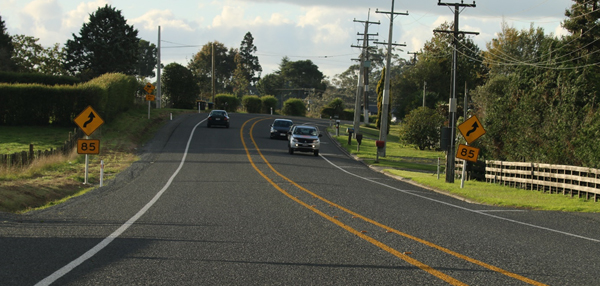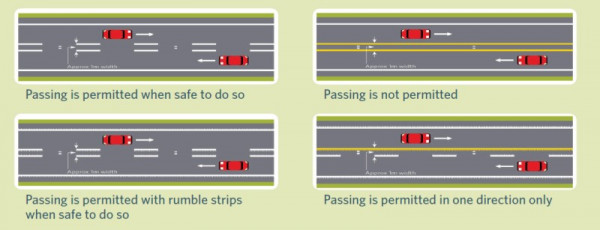Wide centre-lines consist of two lines marked in the centre of the road which provide greater separation for opposing traffic than standard centre-line markings, an example of this is illustrated in Figure 2‑1. The separation helps reduce the likelihood of head on crashes and is typically used on rural roads where ‘crossing the centre-line’ type crashes either exist or there is potential risk of them occurring.
At sample sites, wide centre-lines have reduced all injury crashes by 20%, fatal and serious injury crash rates by 30% and the rate of death and serious injuries by 50% because they are effective in reducing head-on crashes which typically kill or injure more people per crash.
Figure 2‑1: Example use of wide centre-lines on a rural road

Note these are called wide centre-lines in the TCD Rule – but elsewhere in this manual, a wide line simply means a single line marked at a greater width than normal (eg 150mm edgeline or centre-line).
The TCD rule (clause 7.2A(1) and (2)) states:
A road controlling authority may mark wide centre-lines on a roadway if the road controlling authority considers that increasing the separation between traffic travelling in opposite directions would improve the overall operating safety of the road.
Wide centre-lines must be marked with two approximately parallel lines spaced not less than 0.5 m and not more than 1.5 m apart and each of which is one of the following:
(a) a broken or continuous white centre-line that is not less than 100 mm wide; or
(b) a continuous yellow no-passing line that is not less than 100 mm wide; or
(c) a line preceding a no-passing line that is not less than 100 mm wide and consists of a series of yellow dashes, each of which is not longer than 15 m.
For further information on legislation requirements of wide centre-lines refer to clauses 7.1(3)(aa), 7.2(2)(e), 7.2(3)(c)(iv), and 7.3(2)(b) of the TCD Rule.
Wide centre-lines can be used where space between lanes is not intended to be used for turning traffic. Where there is a need for turning vehicles to be protected, a flush median is more appropriate.
Wide centre-lines include the same combinations of centre-line or no-passing lines; that is, they can be a pair of dashed white lines, a pair of solid yellow lines, or a combination of dashed or continuous white or yellow lines (Figure 2‑2). A summary of wide centre-line application is included in Table 2‑7.
Figure 2-2: Typical layouts for wide centre-lines

View larger image [JPG, 54 KB]
Table 2‑7: Wide centre-line markings
|
Application |
Urban/Rural |
|---|---|
|
Colour |
Reflectorised white (standard) or yellow (no-passing) |
|
Width |
Line not less than 100mm wide. |
|
Stripe |
3m line with 7m gap for standard wide centre-line |
|
Length |
A minimum of 80m |
Where wide centre-lines are installed, retroreflective raised pavement markers should be installed in a manner consistent with other markings described within this section. RRPM placement for each of the wide centre-line markings should be suitable for road users for each direction of travel.
Where there is limited shoulder width or fatigue related crashes, the use of audio tactile profiled (ATP) markings alongside or on wide centre-line markings should be considered, however, should be avoided in urban areas due to increased noise.
Audio tactile profiled roadmarkings
Note: where narrower wide centre-lines are used (ie 0.5m - 1m spacing), RRPMs and ATP should be installed on top of, or to the outside of, the marked line (within the lane rather than between the lines). When they are placed on the inside of the marked line, they can diminish the perceptual widening effect at night. The decision on whether to place these delineation devices on top of the markings should be undertaken in conjunction with any potential effects on maintenance costs.
Where wide centre-lines are to be installed, consideration must be given to the needs of all road users (including cyclists) such that the provision of wide centre-lines to increase lateral separation between opposing traffic flows does not disproportionately compromise the road width available for different road user modes.